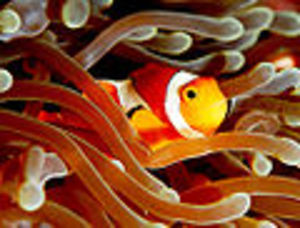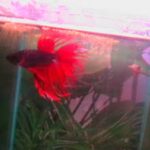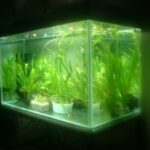So you want to set up a saltwater aquarium, but you don’t want to spent thousands of dollars doing it. In that case, you’ve landed on the right web page. I’ll walk you through the steps that you need to configure a legitimate but budget conscious saltwater fish tank, and give you an idea of how much money you’ll need to spend at each stage of the game. I’ll also explain the basic components of a saltwater aquarium so that you have an idea of why I end up making certain recommendations.
By the end, you’ll have an idea of how much it will cost to set up an entire system. Don’t expect to be able to enter into the saltwater aquarium hobby for as little as the freshwater hobby. It’s a whole different animal. Nonetheless, it can be done for cheaper than many people realize.
Before we begin, let me explain what I mean by a legitimate tank. This is one in which the fish are reasonably well cared for, and the tank has a good chance at thriving. There are corners one could cut to get a cheaper basic saltwater setup, but it would likely lead to unhealthy or dead livestock down the road.
Step 1: Picking a tank
The tank itself is a logical place to start. People often wonder how big a saltwater tank needs to be. Technically, there is no prerequisite size. I’ve seen saltwater tanks as small as half a gallon, and have set one up myself that was less than 1.5 gallons (they call these tanks pico tanks, and it has given birth to a niche hobby of pico reefing). However, for a beginner this is ill advised. Tiny tanks are extremely hard to maintain because the margin of error is so small.
The easiest sized tank to maintain is probably something around 30 gallons or so, which is still on the small side of things when you consider that people commonly maintain reef tanks in the several hundred gallon range.
But if we opt for a 30 gallon tank, that’s going to make all the extra stuff we need to add that much more expensive. So we’re going to go for a 10 gallon tank; they’re cheap and ubiquitous, but big enough that a conscientious beginner should still be able to properly maintain one.
It doesn’t need to be anything fancy. Head to your local Petco, Petsmart, Wal-Mart, or local pet shop and pick up a basic 10 gallon glass aquarium. It should cost you no more than $15.
Step 2: Lighting
This is going to be the single most expensive step in the process. Saltwater aquariums have very different lighting needs than freshwater aquariums. The biology behind this is another topic entirely, but you should know that every single light bulb has something called a kelvin (K) rating, and you can think of it as an indication of the “color” of the light it produces.
Plants require light with a lower kelvin rating (6700 K is considered optimal by many). Most of the regular light bulbs in your house are probably around 6700 K. Saltwater fish tanks, on the other hand, need a higher kelvin rating light source (between 10,000 K and 20,000 K, with 14,000 K being a commonly used midpoint).
People who enjoy do-it-yourself style saltwater aquariums will come up with all manner of different homemade lighting systems. But assuming you’re a beginner, I’m going to recommend that you purchase a light rather than try to rig one, and I’m going to recommend a 20 inch, 28 watt compact fluorescent light by coralife. This has a 10,000k/actinic combo bulb, and you’ll notice it emitting a bluish tinted light (high kelvin rating bulbs look blue, lower kelvin rating bulbs look yellow).
There are four different kinds of saltwater aquarium lights: compact fluorescent, T5 – high output, metal halide, and LED. I’ll spare you all the pros and cons of each, except to say that compact fluorescents are less expensive, will not change your power bill dramatically, and are favored by many beginners.
This light will make your tank a “low light” tank and will prohibit you from keeping certain kinds of things in your aquarium, but what you will be able to keep, you will be able to keep healthy.
This light can be found online for around $50. Add another $5 for the mounting legs (which are not technically required but very beneficial and will make your tank look a lot nicer.
Step 3: Filtration
This is another topic that’s far too complicated to cover completely in this article. The options for saltwater filtration setups are nearly infinite, including sumps, refugiums, traditional HOB (hang on back) filters, deep sand beds, protein skimmers, UV sterilizers, etc.
Feel overwhelmed? Don’t worry, just head back to your local hobby store and purchase an AquaClear (AC) 20. It’s the clear leader in hang on the back filters and you can use it to keep a ten gallon tank in good shape.
When you open it up, you’ll find that it comes with a sponge, a bag of charcoal, and another bag with a bunch of porous looking balls. Throw all that stuff away; you won’t need it. You’re going to fill it with something else (we’ll get to that at the end).
AC 20s typically sell for about $25 at Petco or Petsmart.
Step 4: Circulation
This is sometimes lumped in with filtration, but it’s really a separate topic. Saltwater tanks need water movement, and lots of it. If your aquarium has pockets that stagnate, the condition of the water can get out of balance and bad things can start to happen.
To prevent that, you want to purchase something commonly called a powerhead. It’s basically a little tiny pump that sits fully submerged in the tank and blows water around. Find the smallest powerhead available at your local pet shop. I have had the best experience with maxijet, but almost any brand will do. Opt for one that has an adjustable flow, though, as it will take a little trial and error to figure out what is best for your particular tank.
A small powerhead should cost you around $15.
Step 5: Heating
You’ll need to maintain a constant temp of 78-80 degrees in a healthy saltwater aquarium, so you’re definitely going to need a heater. 50 watts should be sufficient, and it will cost you around $20.
Step 5: Miscellaneous equipment
There are some odds and ends that you’ll need to maintain your tank. You’re going to need a hydrometer (for measuring the salinity of the water), the salt itself, and a water test kit. Bet on $10 for the hydrometer (a swing arm style one, digitals are more expensive), $20 for a starter bag of salt, and $25 for an API test kit.
Step 6: Sand and Live Rock
Live rock is an essential for a saltwater aquarium, as it is a key element of your filtration system. You’ll need to go to an aquarium store for this; Petco sometimes carries it but the quality is extremely poor. $6 per lb constitutes a bargain on live rock, and you need 1 lb per gallon, so expect to pay $60 on this item alone.
Recall that earlier I recommended you throw away all that filtration media that your AC 20 came with. What you want to fill it with instead is live rock rubble. This is separate from the large pieces you will keep and display in your tank. Purchase enough broken down bits of live rock to fill the reservoir in your AC 20. It’s often sold extremely cheap or thrown in for free if you’re making a larger purchase, and it will serve as a more effective filtration medium than the stuff included in the AC.
Some people will try to tell you that you also need to buy live sand. This is not true. The live rock will “seed” the sand and it will become live sand over time, so avoid paying a premium for anything advertised as live sand. A bag of caribsea aragonite (a common basic saltwater substrate) should cost you about $15.
Totaling it all up
Tank – $15
Lighting – $55
Filtration – $25
Circulation – $15
Heating – $20
Misc Equipment – $55
Live rock and sand – $75
Total: $260
It’s very difficult to get a basic saltwater tank system going for less than this. However, you may be able to lower the price by picking up some of the equipment used from other hobbyists. Check http://www.reefcentral.com and http://www.nano-reef.com for local aquarium groups; people buy and sell secondhand equipment often in the aquarium hobby.
You could also opt for an “all-in-one” setup such as an Oceanic Biocube or JBJ NanoCube. There’s nothing wrong with going this route. They are aesthetically pleasing tanks with many advantages. However, they are unlikely to decrease the “grand total” needed to get your first tank up and running.
They also offer the disadvantage of being difficult to upgrade in the future. With the setup that I have detailed, you could easily replace the compact fluorescent light, for instance, with a 70 watt metal halide and keep many new kinds of coral. Those upgrade options are not available to you if you choose an all-in-one tank.
Regardless of what option you pursue, recognize that even at its cheapest, saltwater aquariums are an expensive hobby. You’ll have to keep buying test kits, salt, special water (reverse osmosis filtered), and just when you think you have everything you need, you’ll decide that it’s time to get a digital hydrometer or a more complicated filtration system.
But it’s a rewarding hobby as well, because let’s face it, freshwater fish just don’t compare.






